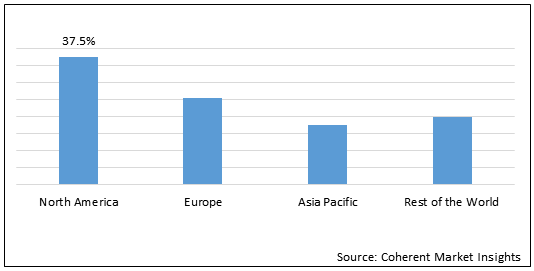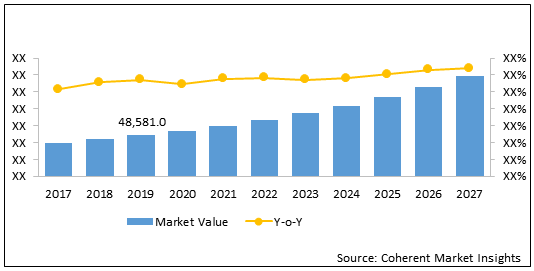Air treatment refers to the cleaning of air of dust, harmful gases, and bacteria, foul odors, heating, cooling, humidifying, and drying the air. Air treatment products include humidifiers, air purifiers, and dehumidifiers. Air purifiers are used to remove air pollutants from the air. Humidifiers are used to increase the level of humidity in the air, a dehumidifier is used to reduce the level of humidity in the air. Air treatment products find a wide range of applications in industrial, commercial, and residential sectors. The air purifiers are mainly used in the residential sector to reduce health concerns and for comfort.
The global air treatment products market is estimated to account for US$ 118,801.3 Mn in terms of value by the end of 2027.
Market Dynamics- Drivers
Air pollution levels have increased significantly worldwide in the recent past. As a result of this, poor indoor quality has become a prevalent issue leading to increased cases of asthma and chronic obstructive pulmonary disorders (COPD). According to the World Health Organization (WHO), over 3 million premature deaths are reported each year associated with respiratory conditions. By 2050, this number is expected to reach 6.6 million each year. Moreover, according to the Nature Journal, particle sizes PM2.5 and PM10 in the air as a result of pollution, are inhaled deep into the lungs. According to the same sources, this can lead to increased incidence of heart attacks and strokes, accounting for over 2/3rd of 3.3 million premature deaths annually, with other fatalities linked to respiratory diseases and lung cancer. Air purifiers aid in removing air particles, microorganisms, and air pollutants and therefore, enhance the indoor air quality. Hence, these factors are expected to drive growth of the global air treatment products market during the forecast period.
According to Coherent Market Insights’ analysis, the global construction industry is expected to witness stable growth of 4.3% per annum through 2025. Rising population and shift from joint families to nuclear families have aided growth of the construction industry. Furthermore, during construction concrete slabs with elevated moisture levels take longer time to dry, resulting in a delay in project completion. Deployment of dehumidifiers helps significantly reduce the drying time of concrete slabs, speed up painting & coating operations, and assist in the restoration of buildings after flood damage. Therefore, these factors are expected to propel the global air treatment products market growth over the forecast period.
Statistics:
North America held dominant position in the global air treatment products market in 2019, accounting for 37.5% share in terms of value, followed by Europe, RoW and Asia-Pacific respectively.
Figure 1: Global Air Treatment Products Market Share (%), in terms of Value, By Region, 2019

To learn more about this report, Download Free Sample
Market Dynamics- Restraints
According to the World Health Organization (WHO), Beijing, China was the most polluted city in the world with 13 cities in India among the 20 most polluted cities worldwide. Furthermore, the WHO has raised red flags in India over degrading air quality. However, penetration of air purifiers and other air treatment products in the market is low in this region. The air purifiers market in India has grown over the last few years, albeit at a slow pace. Most customers of the products are commercial spaces, offices, institutions, and luxury hotels. Thus, the lack of adoption in emerging economies is expected to hamper the global air treatment products market growth over the forecast period.
Marketing plays a vital role in the sales of air treatment products market. However, exaggerated marketing has led to confusion among consumers in developed countries. The market has offers a number of options to consumers in terms of sizes and prices of air treatment products. This has resulted in misleading customers in buying the products. Therefore, these factors are expected to restrain growth of the global air treatment market during the forecast period.
Air Treatment Products Market Report Coverage
| Report Coverage | Details | ||
|---|---|---|---|
| Base Year: | 2019 | Market Size in 2019: | US$ 48,581.0 Mn |
| Historical Data for: | 2016 to 2019 | Forecast Period: | 2020 to 2027 |
| Forecast Period 2020 to 2027 CAGR: | 11.8% | 2027 Value Projection: | US$ 118,801.3 Mn |
| Geographies covered: |
|
||
| Segments covered: |
|
||
| Companies covered: |
Atlas Copco AB, AMFAH Group, Samsung Electronics Co., Ltd., Winix Inc., Panasonic Corporation, De’Longhi S.p.A., Sharp Corporation, and Honeywell International Inc. |
||
| Growth Drivers: |
|
||
| Restraints & Challenges: |
|
||
Uncover macros and micros vetted on 75+ parameters: Get instant access to report
Market Opportunities
Healthcare and hospitality sector has emerged as a major target for air treatment products companies. Air treatment products have become the primary suite of equipment for any healthcare facility. With increasing number of patients in hospitals, concerns for healthcare-acquired infections (HAI) have been growing in the recent past, especially for caregivers such as doctors, nurses, other hospital staff, and those accompanying patients. According to the American College of Allergy, Asthma & Immunology (ACAAI), in 2010, 75% of Allergists in the U.S. recommended air purifiers to their patients as part of an overall allergy/asthma treatment program.
Indoor air pollutants are unwanted and harmful materials. According to the U.S. Environmental Protection Agency, indoor air pollutants, which mainly comprise particulate matter and gaseous pollutants, are among the top five causes of environmental and health risks. In the recent past, an increasing number of scientific studies have indicated that the air inside homes can be as polluted as the air outdoors. Hence, governments of various countries are promoting various indoor air quality programs in order to create awareness among people regarding the need for protective measures such as the use of air purifiers in homes. For instance, the U.S. Environmental Protection Agency (EPA) and the U.S. Consumer Product Safety Commission (CPSC) have prepared a safety guide to help people to reduce the levels of indoor air pollution in residences.
Figure 2: Global Air Treatment Products Market Value (US$ Mn), 2017 - 2027

To learn more about this report, Download Free Sample
The global air treatment products market was valued at US$ 48,581.0 Mn in 2019 and is forecast to reach a value of US$ 118,801.3133 Mn by 2027 at a CAGR of 11.8% between 2020 and 2027.
Market Trends
Dehumidifiers remove moisture from the air by using compressors, condenser coils, and fans. This in turn results in the consumption of significant amounts of energy. Reducing energy consumption as well as providing multiple functions such as air-purifying, cooling, and dehumidifying in a single electronic device has emerged the recent trend in the past few years. Major companies are focusing on providing a single solution that fulfills all essential purposes. For instance, in September 2015, LG Electronics introduced LG Dehumidifier in Singapore, which is a four-in-one, user-friendly solution.
Key market players are focused on research and development activities, in order to enhance the market presence. For instance, in May 2016, Crusaders Technologies launched its new air purifier, XJ-3100. In May 2015, Panasonic launched New Air Hub F-VK655H with HEPA composite filter, which removes 0.3 μm fine particles up to 99.97%. Furthermore, in October 2014, Dyson launched humidifiers that help to prevent blocked sinuses and dehydration of the skin.
Regulations
Energy Conservation Standards for Residential Dehumidifiers
The Department of Energy (DOE) has regulated the energy efficiency level of residential dehumidifiers since 2007. The standard mandatory in 2007 will save around 0.27 quads of energy and result in approximately $3.14 billion in energy bill savings for products shipped from 2007-2031. The standard will avoid about 14.1 million metric tons of carbon dioxide emissions, equivalent to the annual greenhouse gas emissions of about 2.8 million automobiles.
Global Air Treatment Products Market - Impact of Coronavirus (Covid-19) Pandemic
Due to Covid-19 pandemic, many industries witnessed significant shift in their business. The COVID-19 outbreak has created many lucrative opportunities for air purifier manufacturers with high-performance units comprising activated carbon technologies, high-efficiency particulate air (HEPA) filters, Ion & Ozone Generators, Electrostatic Precipitator, and many other technologies in order to contain the spread of virus for enclosed spaces. Air purifiers with HEPA filters are very effective at filtering out viruses such as coronavirus. For instance, according to data compiled by the World Health Organization, poor ventilation can lead to an increase in virus transmission. Thus, air manufacturers are focusing on introducing air purifiers with advanced technology and improved air ventilation, which is helpful to combat COVID-19. Thus, manufacturers are providing solutions for indoor environments, thus leading to increase in demand for air purifiers in the future.
Competitive Section
Key players involved in the global air treatment products are Atlas Copco AB, AMFAH Group, Samsung Electronics Co., Ltd., Winix Inc., Panasonic Corporation, De’Longhi S.p.A., Sharp Corporation, and Honeywell International Inc.
Key Developments
Share
Share
Missing comfort of reading report in your local language? Find your preferred language :
Transform your Strategy with Exclusive Trending Reports :
Select a License Type
Joining thousands of companies around the world committed to making the Excellent Business Solutions.
View All Our Clients